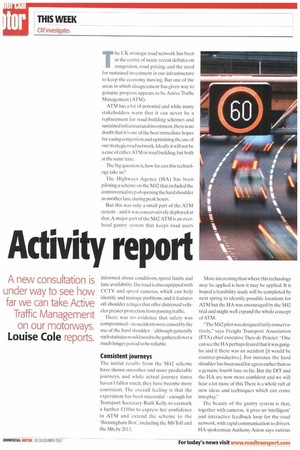Activity report
Page 30

Page 31

If you've noticed an error in this article please click here to report it so we can fix it.
A new consultation is under way to see how far we can take Active Traffic Management on our motorways. Louise Cole reports.
The UK strategic road network has been at the centre of many recent debates on congestion, road pricing, and the need for sustained investment in our infrastructure to keep the economy moving. But one of the areas in which disagreement has given way to genuine progress appears to he Active Traffic Management (ATM).
ATM has a lot of potential and while many stakeholders warn that it can never be a replacement for road-building schemes and sustained infrastructural invest ment, there is no doubt that it's one of the best immediate hopes for easing congestion and optimising the use of our strategic road network. Ideally it will not be a case of either ATM or road building, but both at the same time.
The big question is, how far can this technology take us?
The Highways Agency (HA) has been piloting a scheme on the M42 that included the controversial step of opening the hard shoulder as another lane during peak hours.
But this was only a small part of the ATM system and it was conservatively deployed at that. A major part of the M42 ATM is an overhead gantry system that keeps road users informed about conditions, speed limits and lane availability.The road is also equipped with CCTV and speed cameras, which can help identify and manage problems. and it features off-shoulder refuges that offer distressed vehicles greater protection from passing traffic.
There was no evidence that safety was compromisedno accidents were caused by the use of the hard shoulder although generally such statistics would need to be gathered over a much longer period to he reliable.
Consistent journeys The initial results from the M42 scheme have shown smoother and more predictable journeys, and while actual journey times haven't fallen much, they have become more consistent. The overall feeling is that the experiment has been successful enough for Transport Secretary Ruth Kelly to earmark a further £150m to express her confidence in ATM and extend the scheme to the 'Birmingham Box', including the M6 Toll and the Mfi, by 2011. More interesting than where this technology may be applied is how it may be applied. It is hoped a feasibility study will be completed by next spring to identify possible locations for ATM but the HA was encouraged by the M42 trial and might well expand the whole concept of ATM.
"'Me M42 pilot was designed fairly conservatively," says Freight Transport Association (FTA) chief executive Theo de Pencier. "One can see the HA perhaps feared that it was gungho and if there was an accident [it would be counter-productive]. For instance the hard shoulder has been used for egress rather than as a genuine fourth lane so far. But the DtT and the HA are now more confident and we will hear a lot more of this. There is a whole raft of new ideas and techniques which can come into play."
The beauty of the gantry system is that, together with cameras, it gives an 'intelligent' and interactive feedback loop for the road network, with rapid communication to drivers. HA spokesman Anthony Aston says various concepts are being discussed: "The feasibility study will focus on how we can use advanced signalling to control traffic.This could take the form of differential speed limits on lanes. LGVon ly lanes,or through-traffic lanes. For instance. on the M42 between the M40 joining and the M6 junction to leave the motorway, one third of traffic drives the entire stretch. It is this kind of information we wish to use.
"There could also be high-occupancy lanes, with multiple passengers in vehicles. This has been used in the States, but not here so far."
Further uses Aston won't be drawn on the other potential developments of ATM for instance that it could form the basis of price differentials on roads, with some lanes being offered at a premium: "Nothing is being ruled out but certainly at the moment the main concepts arc the four outlined."
These concepts and the areas of the trunk network that could most benefit are being discussed with 'stakeholders' including the FTA, the Road Haulage Association, AA, RAC and other road user groups.To underline the Department for Transport's (DfT) commitment to bringing ATM to the masses, Kelly herself attended the first consultation meeting run by Derek Wadsworth, director general of networks within the DfT.
The FTA's de Pencier,for one, believes ATM will solve many logistical problems but may also lead us into some more political arenas: -It could be used for variable lane pricing eventually. There is also the issue of privacy if we have too much technology tracking motoring movements, but the HA is paying particular attention to this. I think politicians are sometimes more sensitive about those things than many of the rest of us would be."
He believes most stakeholders agree that ATM could be advantageous to road users, provided that it does not replace strategic investment in road building or widening. And, one has to ask, how often are all the key players in transport behind a
































































































































































































